
The Colletidae are a family of bees, and are often referred to collectively as plasterer bees or polyester bees, due to the method of smoothing the walls of their nest cells with secretions applied with their mouthparts; these secretions dry into a cellophane-like lining. The five subfamilies, 54 genera, and over 2000 species are all evidently solitary, though many nest in aggregations. Two of the subfamilies, Euryglossinae and Hylaeinae, lack the external pollen-carrying apparatus that otherwise characterizes most bees, and instead carry the pollen in their crops. These groups, and most genera in this family, have liquid or semiliquid pollen masses on which the larvae develop.
Ptiloglossa is a small genus of bees within the family Colletidae, endemic to the Americas. Ptiloglossa is one of the most common nocturnal groups of colletids.
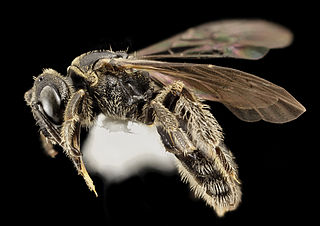
Pseudopanurgus is a genus of mining bees in the family Andrenidae. There are at least 130 described species in Pseudopanurgus. Pseudopanurgus bees often have 2 submarginal cells in their forewings. Their sizes range from 3 mm to 10 mm.
Mexalictus arizonensis, the Arizona mexalictus, is a species of sweat bee in the family Halictidae.
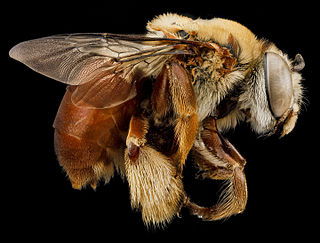
Centris errans, known generally as wandering centris, is a species of centridine bee in the family Apidae. Other common names include the Florida locust-berry oil-collecting bee and spiny bear's-breech. It is found in the Caribbean and North America. The species is one of five from the family Apidae that are endemic to the state of Florida. The species occurs the southernmost portion of Florida.

Nomiinae is a subfamily of sweat bees in the family Halictidae. There are about 11 genera and at least 550 described species in Nomiinae.
Melecta edwardsii, or Edward's melectum, is a species of digger-cuckoo bee in the family Apidae. It is found in Central America and North America.
Calliopsis linsleyi is a species of mining bee in the family Andrenidae. It is found in Central America and North America.
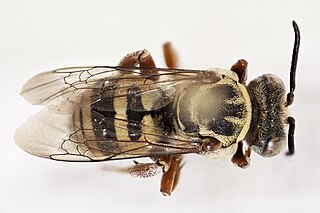
Triepeolus martini is a species of cuckoo bee in the family Apidae. It is found in the United States and Mexico.

Brachynomadini is a tribe of cuckoo bees in the family Apidae. There are at least 5 genera and 20 described species in Brachynomadini.
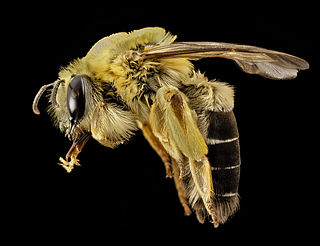
Diphaglossinae is a subfamily of bees in the family Colletidae. There are 9 genera and more than 130 described species in Diphaglossinae.

The bumped miner bee is a species of miner bee in the family Andrenidae. Another common name for this species is the Nason's andrena. It is found in Central America and North America. It is a generalist, collects pollen from many different plants.
Colletes longifacies is a species of hymenopteran in the family Colletidae. It is found in North America. The species is one of five from the family Colletidae that are endemic to the state of Florida. The species occurs in North-Central Peninsular Florida and the Panhandle.

Chelostoma campanularum, or the harebell carpenter bee, is a species of hymenopteran in the family Megachilidae. It is found in Europe and Northern Asia and North America.

Perdita minima is a species of mining bee in the family Andrenidae. It is found in North America.

Brachymelecta californica, also known as the California digger-cuckoo bee, is a species of cuckoo bee in the family Apidae, found in Central America and North America.
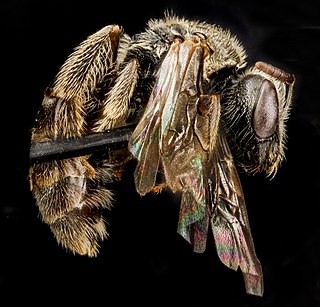
Lasioglossum oenotherae is a species of sweat bee in the family Halictidae.

Protandrena is a genus of mining bees in the family Andrenidae. Depending upon whose definition of the genus one follows, there are anywhere from 50 to 180 described species in Protandrena; traditional classifications recognize 7 subgenera, some of which are sometimes elevated to genus rank, and other classifications place many of these species in the related genus Pseudopanurgus (e.g.), leaving Protandrena with a much smaller constituency. In the most inclusive definition, they are found from Canada through Argentina. However, there is current disagreement whether the Protandrena in South America belong to different genera, in which case the genus extends only as far south as Panama. They are solitary bees, but some species nest in aggregations. They prefer to nest in sunny areas with sparse vegetation. The underground nests have cells lined with a chemical substance. This "wallpaper" acts as a barrier between fungi and bacteria. The eggs hatch, the larvae develop, and then overwinter as mature larvae with hardened skin. They are primarily active from May to October, but have been noted to be active in April in the region six of the United States.

Chelostoma philadelphi is a species of hymenopteran in the family Megachilidae. It is found in North America.

Lasioglossum reticulatum is a species of sweat bee in the family Halictidae.#














